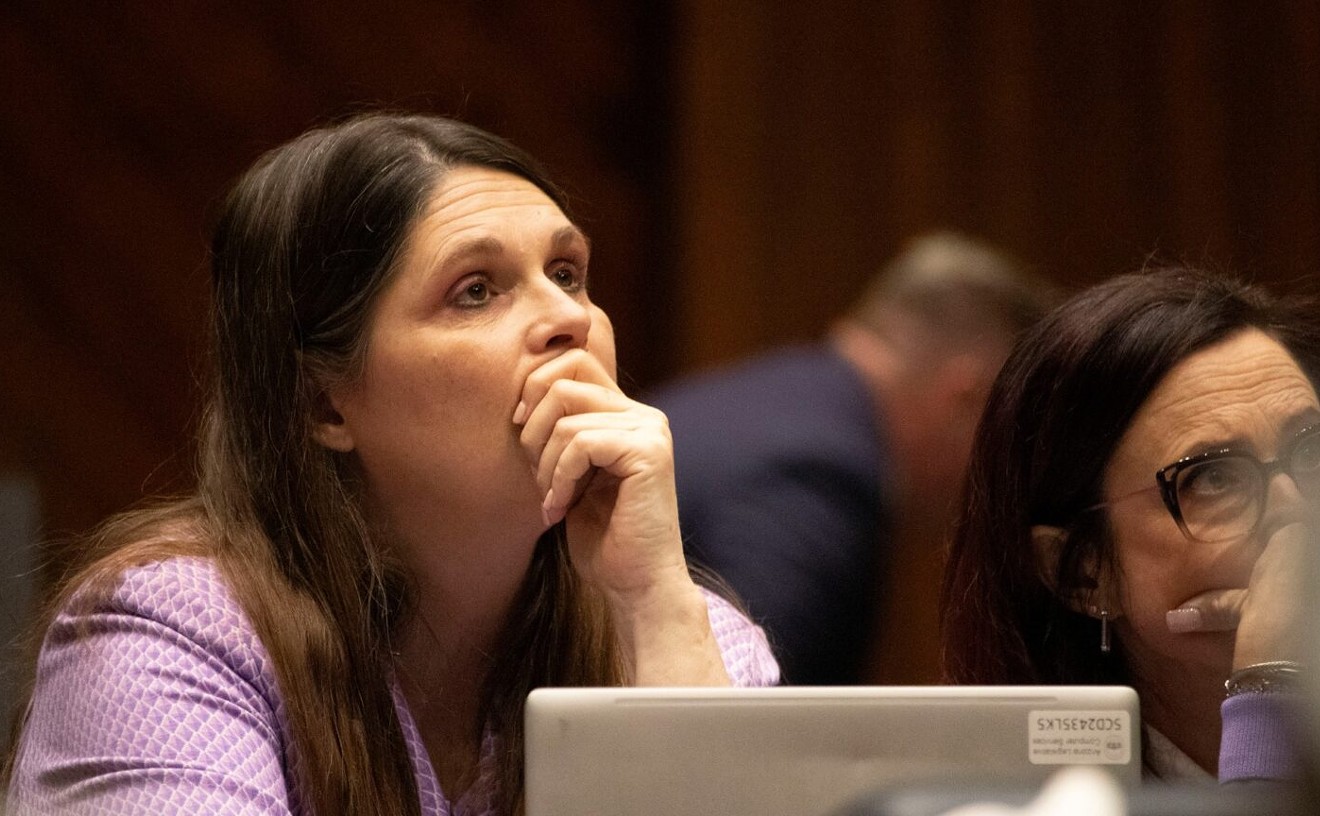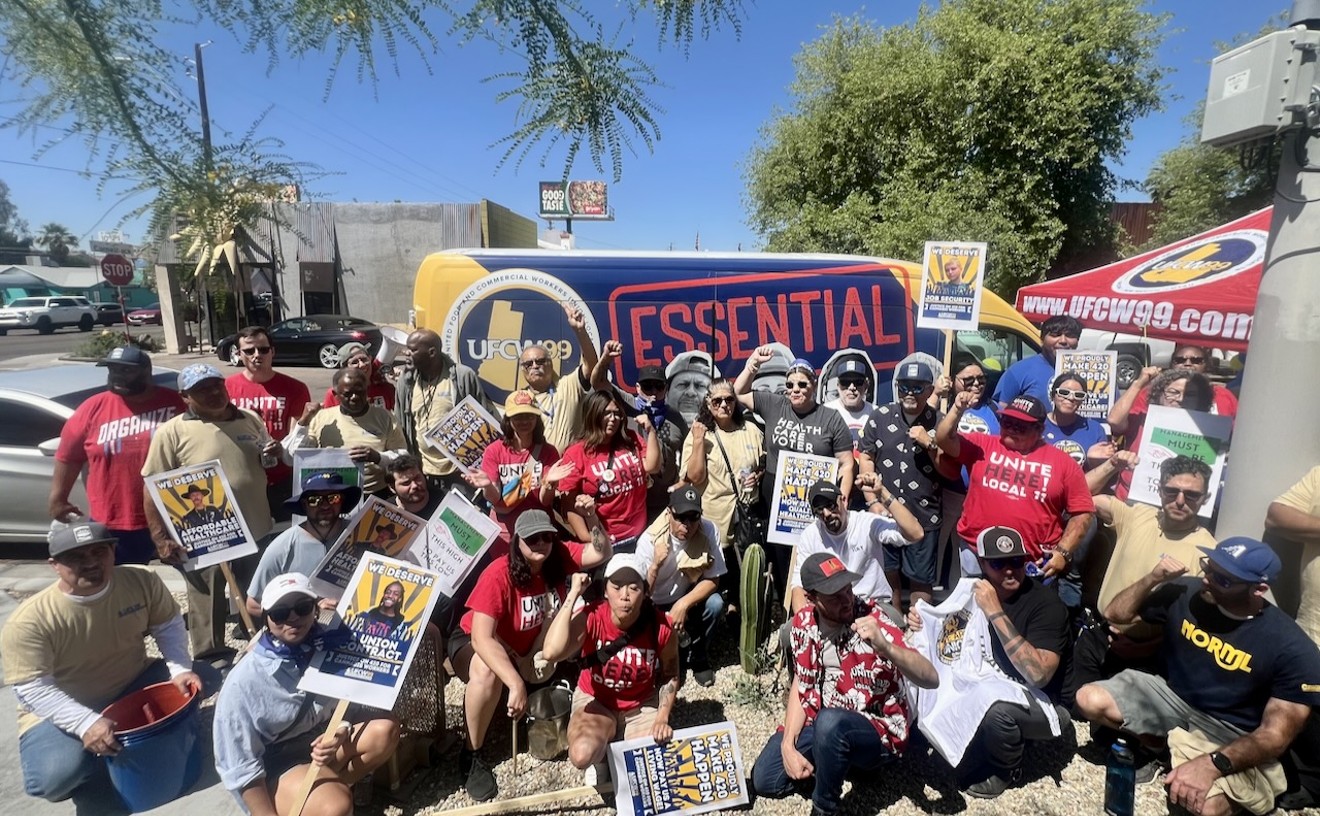That his death would be shrouded by enigma is only fitting. Hodge himself lived a life so private that many of the pertinent details were unknown by his friends and fellow workers. Everyone liked and admired Hodge. But no one actually knew much about him.
Although unfailingly charming and outgoing, Hodge was an exceedingly private person who never volunteered particulars either about his personal life or his past.
What makes this unusual is that so many people who make their careers in the newspaper business spend a great deal of their time boasting about their past exploits, either real or imagined.
Bob Early, who was Hodge's editor both at Arizona Highways and the Arizona Republic, found that out only after agreeing to speak at Hodge's memorial service.
"He worked for me more than ten years," Early says. "When I sat down to write my remarks about him, I realized I knew almost nothing about him other than the fact that he was a fine writer and a wonderful guy to be around."
Carle Hodge kept his own peace. He maintained that stance until the end of his life, which came in the early-morning hours of September 30. He was beaten to death in front of his apartment, police say, by an 18-year-old street punk with a lengthy criminal record.
If I were asked to pick the half-dozen most interesting people I've met in the newspaper business, Hodge's name would easily be high on the list. But I never knew much about him, either.
He was of medium height, had a full head of hair and carefully cultivated a drooping mustache much like Mark Twain's. Hodge strode with a limp caused by a childhood disease that resulted in a shortened leg. But like Melville's ivory-legged Captain Ahab, Hodge limped with his head held high and his chest stuck out.
He habitually smoked or cradled in his hand one of his 15 pipes. He loved the company of women, was an omnivorous reader and never faltered in his pursuit of the craft of writing. And, happily, he could down dry martinis with the lan of a Russian general officer.
Hodge married five times and produced three children, now all grown. And during his final years, he lived with Sylvia Cody, a most attractive young editor more than 30 years his junior.
After Hodge's death on September 30, not one but two memorial services were held for him. This was necessitated by the fact that he had worked for newspapers in both Tucson and Phoenix.
At the Tucson service, held there in the botanical gardens, Pete Cowgill, an old companion and an outdoors writer, openly expressed his annoyance at the setting.
"Carl would be pissed off," Cowgill said, "that we weren't all together toasting him in a bar."
Hodge's journalistic career began in his hometown of Fort Worth, Texas, and included jobs with Time, Newsweek, the New York Daily News and Associated Press. He traveled around the world on assignments. In Arizona, he worked for the Arizona Daily Star in Tucson and the Republic here in Phoenix. He was a highly valued contract writer for Arizona Highways magazine at the time of his death.
A story Hodge wrote on astronomy for Arizona Highways is scheduled to be the cover article next April, says Early, the magazine's editor. Another, on the 100th anniversary of the Lowell Observatory in Flagstaff, is scheduled for next May.
Although Hodge was a professional writer all his life, he never stopped trying to improve his technique, according to those who worked with him through the years. He apparently spent his entire life in quest of new words and ever more felicitous phrases for use in his stories.
Bernard Merems, who now lives in Patagonia, was Hodge's copy boy at Time magazine in the 1950s. During that period, Hodge was something of a dashing figure, Merems says, who frequently moved about New York City with a ballerina on his arm.
In those days, Hodge edited what Time magazine called "The Press" section. Now dormant, it was an immensely influential part of the magazine, because its editor had the power to skewer the nation's press lords and to both make and break the reputations of journalism's biggest names.
One of the people Hodge helped in those days was Fredric March, the famous film actor. March had been accused of being a Communist sympathizer during the McCarthy scare years. Hodge wrote a piece clearing him. That was in the 1950s.
More than a decade later, in 1967, March looked up Hodge in Tucson to thank him. March was there to make a Western movie with Paul Newman called Hombre.
Merems still remembers a line Hodge wrote about a well-known publisher of the day: "When he smiled, he looked like he had just bitten into an overripe persimmon."
"I was just out of Brooklyn College," Merems says, "and Carle became my mentor. I always thought he was so much older than I was. It later turned out that he was only ten years my senior. But he was so much more sophisticated.
"It was Carle who took me to restaurants and taught me how to use a fork and spoon to roll spaghetti."
Merems remembers a telling detail about Hodge's early career:
"Carle had a daily ritual. He never stopped working to improve his writing. Each morning, Carle would take every story on the front page of the New York Times and rewrite the lead paragraphs, trying to improve them. To me, it was a revelation. It was like watching Vladimir Horowitz practicing the piano."
Virginia Fraps Hodge refers to herself as "Carle's favorite ex-wife." She speaks of him with affection.
Now a librarian at the Copper Queen Library in Bisbee, she recalls finding slips of paper and envelopes among his papers containing lists of words and phrases for use in future writings.
"The trouble was," she says, "that the lists were often on the backs of envelopes that still contained unpaid bills or on the opposite sides of grocery lists that were never taken to the store."
Bob Albano, now city editor of the Santa Fe New Mexican, holds Hodge in high esteem. Albano was one of Hodge's editors during his years at the Arizona Republic.
Albano says:
"Carl developed a certain reverence for whatever topic he was writing about. He had a knack of putting a science story into language that people enjoyed reading. He was a first-rate science writer."
Maggie Hodge, Carle Hodge's 26-year-old daughter, works for a Tucson radio station. They had grown increasingly closer in recent years.
Maggie recalls a visit with Carle about a week before his death.
"Papa and I had grown very close," she says. "He came down to Tucson because he was working on a story about the Biosphere, and we had lunch together at the Tohono Chul tearoom, with its fabulous garden setting.
"We walked around the grounds together. Papa became fascinated by some rabbits that he saw eating chunks of adobe. He wanted to find out why they liked it. He was always planning his next writing project . . . ever seeking for expanded knowledge."
Maggie recalls attending a science convention with her father.
"The language was so technical that I understood almost nothing of what went on. Later, I sat down with Papa and he explained it all to me in layman's language. Suddenly, it all became clear to me. He was really a great teacher."
Marilyn Taylor, a writer, worked with Hodge at the Republic. "I was just getting started," she says, "and he was incredibly supportive. He kept encouraging me to develop my own style."
Early holds annual meetings for his Arizona Highways writers. At the most recent meeting, Hodge told Early about the longevity of his relatives, indicating that Carle expected to live a long life, too.
@rule:
@body:Police theorize that Hodge was in his apartment in the 2100 block of West Missouri when he saw someone tampering with his car in the parking lot.
He ran out into the street barefoot to chase him away.
Witnesses recall seeing a man about 5 feet 8 inches tall, dressed in black, beating and kicking Carle into submission.
They recall hearing Carle say, "Please don't hit me."
The man then dragged Carle's body into the street. He jumped into his own car, which contained either one or two other passengers. He spun the car around and then deliberately drove over Carle's body.
For several days, the police investigation was stymied. Then, after the Republic offered a $5,000 reward, the police announced the arrest of Efren Medina of 5730 West Indian School.
It has been theorized that Medina was turned in for the reward by one of the two people who were with him in the car.
Medina is a member of the Hollywood Gang, which, along with another group calling itself Wetback Power, terrorizes people in the Maryvale area.
Medina already has a lengthy criminal record. He is a chief suspect in the February 5 killing of a cocaine dealer named Thomas Scroggins, 30.
Scroggins bled to death after suffering wounds to his legs caused by both a .22-caliber weapon and a 12-gauge shotgun. Shells from these weapons were recovered from Medina's home. Two witnesses told police they were with Medina until moments before the kidnaping of Scroggins. But County Attorney Rick Romley refused to take the case. He said he needed more evidence.
While Romley and his cowardly prosecutors waited for evidence, Carle Hodge was beaten to death.
The reason for not going to trial was typical of Romley's constant political posturing. His spineless prosecutors do not go to trial unless they have a sure shot at victory and a chance to be interviewed on television.
Romley and his prosecutors always exercise inordinate care in these kinds of cases. Despite their protestations, they worry more about their won-lost records than safety in the streets.
Medina has also been charged with shooting a man named Dennis Smith, 35, in 1991. He shot Smith nine times with a pistol and left him permanently disabled, police report.
For this crime, Medina was sent to the Adobe Mountain School, but was released a month before the Scroggins killing.
I tried to make an appointment to visit Medina in the county jail, where he is now being held.
Lisa Allen, the sheriff's public relations representative, seemed annoyed by the request.
"The Republic and the television stations have already asked," Allen said.
"Mr. Medina refused their requests. So I'm not going to ask him again. You see, we don't allow our prisoners to be harassed."
I drove out to Medina's house on Indian School. It is a single-story house with bars on all the windows, as if the residents live in constant fear of criminals.
It was early on a Sunday evening. The lights were out. No one answered. But I heard footsteps moving about inside and the sound of television.
I had been trying to reach Sylvia Cody, who lived with Carle, for days. So I made one last try.
The phone rang five times. Then the unmistakable sound of Carle's voice came on the line.
"Sylvia and I are not available at the moment," Carle said. "But we'll return your call if you leave a message."
I didn't know what to say.










